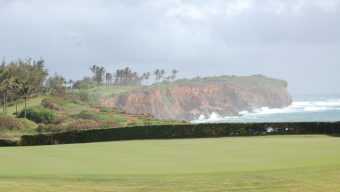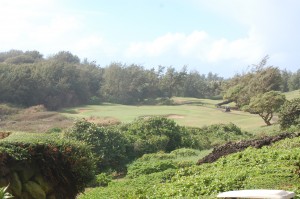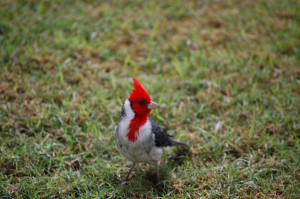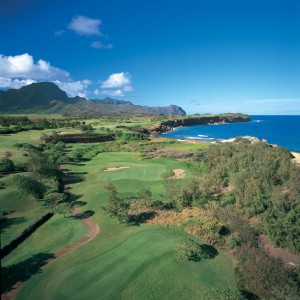Editor’s Note: During this difficult time dealing with the Coronavirus outbreak, leaving golf writers nothing to write about, we decided to revisit some of the places we have gone over the years. Today, we look at Poipu Bay.
KOLOA, Hi. – Hidden away in the non-accessible areas of the Kauai’s Poipu Bay golf course are several heiaus, ancient places of worship established by the island’s natives half a millennium ago.
Those ancient people only built their sacred sites in areas with enough mana, a spiritual power that they believe emanates from the ground.
You might want to channel some of that mana to take on this 7,123-yard layout, designed by Robert Trent Jones, Jr., in 1991. It’s a challenge, especially when the capricious winds blow. The course is at exposed south end of the island, sitting on a bluff about 100 feet above the Pacific, where the winds always blows, at times, capriciously.
Craig Sasada, Poipu Bay’s director of golf, didn’t have time during our visit to discuss his course but did shoot the breeze briefly about the wind.
“When the south winds come, that’s when it’s gets really hard, any course in Hawaii,” he said. “The holes get much longer and everything just changes.”
Unlike some other island courses, this one is more wide open, with fewer trees and fewer thick brush hazards. That openness, especially on the back nine, makes it more susceptible to the vagaries of the breezes.
The course has been tested by the game’s best players. Tiger Woods has had more success here than just about anywhere on the planet. For 13 years, from 1994 to 2006, Poipu hosted the 36-hole PGA Grand Slam of Golf tournament, featuring the four winners of that year’s ‘majors.’ Woods has won seven of those events, including five in a row from 1998 to 2002.
Phil Mickelson won the Grand Slam in 2004, setting the course record with a 13-under 59 on his second round.
Most of us likely would be closer to the reverse of Phil’s number, but whatever the result it’s worth the effort.
The 210-acre footprint is snuggled between the sea and the rugged mountains. The most distinctive peak is a rock formation called Mahualepu, said to be an Hawaiian god totally submerged except for his pointy nose.
The course features 85 bunkers and five water hazards – not including the Pacific Ocean. You get to see much of the Pacific, in spectacular fashion, over most of the finishing holes.
Poipu Bay is really two different courses. The front nine is more inland, not as many ocean views, more secluded. This is where you can, perhaps, control your score, although the 209-yard, par-3 third hole – against the prevailing wind – is a bogey waiting to happen.
The fourth and fifth holes, seemingly short at 380 and 355 yards, respectively, but they play directly into the wind. Club down. In addition, Robert Jones has a tendency to place bunkers in the same areas where your ball will be landing, generally on the right and left sides of the fairway.
The par-3 seventh hole is a 179-yard all-carry approach – over a wide lake. The green is just behind the water but there’s room on the left to bail.
The ninth is a par-4, 420-yard challenge. It’s the No. 1 handicap hole and there’s some wind to deal with it because you are heading toward the ocean. At one point, the fairway is just 24-yards wide. The green is on an up slope so, again, club down to reach it.
The ninth green also is where a heiau is located, just to the right of the hole. Feel the mana. It should be noted that if a ball ends up in a heiau, local rules do not allow you to hit it out of there. You must drop another ball and take a one-stroke penalty. Those ancients played it by the book.
It’s a different course on the back nine. You can feel it. You can see it. It’s a rising plateau to the sea, allowing wind protection over the first four holes. Then it’s a journey along the coastal bluff over the next four holes and finally playing inland to the tough island-green 18th.
The 11th is a tricky par-3, 193 yards. There’s a large lake to the right of the green and the prevailing winds are left to right, sometimes quite hard. You have to take this out left, where there’s plenty of landing area, or it could carry across the green and into the water. Speaking from experience.
Water again comes into play on the 384-yard, par-4 13th. A lake to the right of the green can be reached by some. The smart play is lay up left. The approach is touchy because the water on the right is so close to the green.
The 15th and 16th (picture above, looking back) are par-4 beauties, downhill and downwind, with the wild Pacific on the left. The 15th is 427 yards and plays shorter because it’s with the wind. The 16th is 501 yards, which seems quite long for a par-4, but it’s reachable in two because of the strong winds sweeping up from the sea.
Don’t forget to glance back at the high seas and red rock cliffs as you walk to your shots. It’s one of the best scenes on the island, on all the islands. You also may be able to see some sea life over the ancient lave-rock wall, humpback whales, monk seals or sea turtles.
The final two holes are pure pleasures – although not so much if you mess up. The par-3, 201-yard 17th is into a valley off an elevated tee. There’s no room for error on the left and to be short is too be dead.
Finally, the par-5 18th swings back inland toward the clubhouse with a layup second shot short of a lake that nearly surrounds the green. That allows a nervous chip to the green.
May the mana be with you.
MONDAY: Kauai Lagoons
























